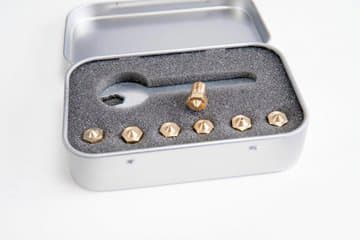When it comes to dialing in your 3D printer, the nozzle is often overlooked. As the last part to be in contact with filament, the nozzle can influence strength, print time, and print material. Here we take an in-depth look into 3D printer nozzle size and material.
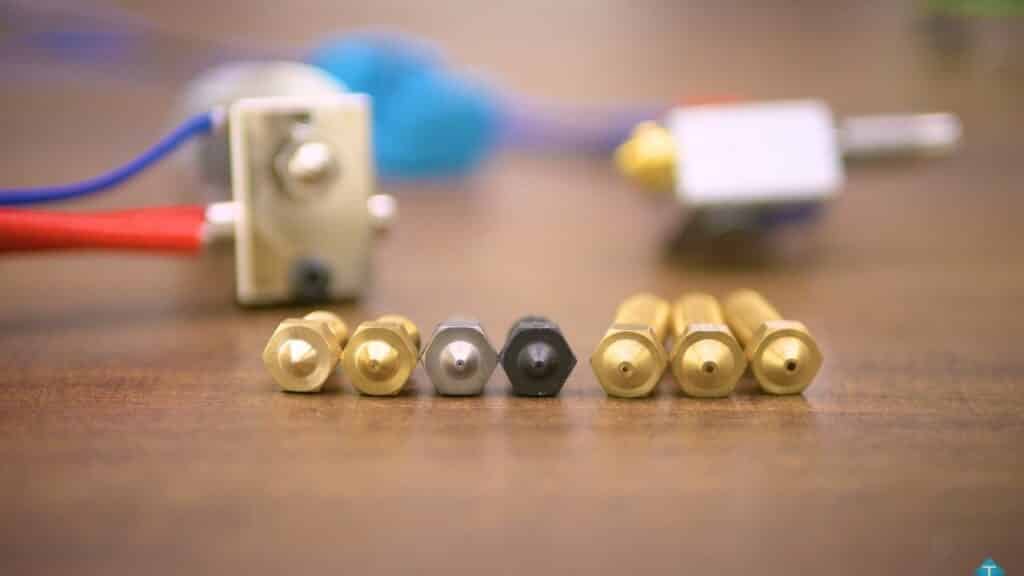
Introduction
With so many things to consider when 3D printing, it’s almost overwhelming. We could go on and on listing the 50+ settings that need reviewing before starting a print.
One part of setting up the printer that is often overlooked is the nozzle. As the last part to be in contact with the filament, selecting the correct nozzle can be very important in taking the next step in improving your 3D printing skills.
For most of us, knowing what the differences between nozzles are as well as the advantages and disadvantages will be enough to send us makers off to the races. So let’s review why nozzles are important, what makes them different, and some of their advantages and disadvantages.
The nozzle is the part on the 3D printer that actually extrudes the filament to build the part. As you can imagine, this can have a large impact on how long your part takes to print as well as the quality of the final object. The key characteristics to look for are therefore the 3D printer nozzle size and material.
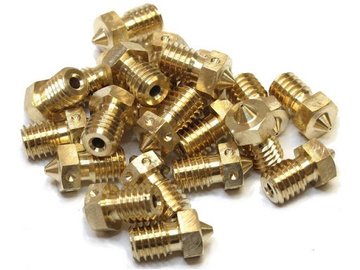
3D Printer Nozzles Size: Large vs Small
Nozzle diameters generally range from 0.1 mm all the way up to 1.0 mm. This gives a maker great flexibility in choosing a nozzle, but with so many options, which one is best?
When selecting a 3D printing nozzle, it’s all about balancing how much filament is extruded and how fast. It probably goes without saying that a larger nozzle (>0.4mm) will extrude more material than a smaller nozzle (<0.4mm), but how it affects the 3D print may be less obvious. Here are some general guidelines on the differences between using a larger nozzle and a smaller nozzle:
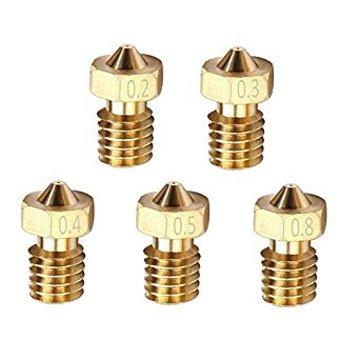
Larger Nozzles (>0.4 mm):
- High strength
- Reduced print time
- Fewer nozzle-related print errors
Smaller Nozzles (<0.4 mm):
- Higher precision
- Clogs often
- Higher quality overhangs
- Supports are easier to remove
It’s important to carefully review your needs before selecting a nozzle. The most common nozzle size used is 0.4 mm because it provides a good balance between print speed and precision. In general, using a 0.4-mm nozzle will offer decent flexibility, but for those of us looking to squeeze as much performance out of our printer as possible, changing the nozzle is a quick and cheap way to do so.
3D Printer Nozzle Material
Oftentimes 3D printers come with a standard brass nozzle. But if you’ve spent even a little time looking into 3D printing nozzles, you’ll know that brass is not the only material used. You can also find stainless steel, hardened steel, ruby tipped, and more.
When printing more exotic materials, it’s important to understand which type of nozzle material to use. Using the wrong material type for your filament can cause damage to the nozzle and ruin your build. Here’s a good guideline when determining which materials can be used with the different kinds of nozzles.
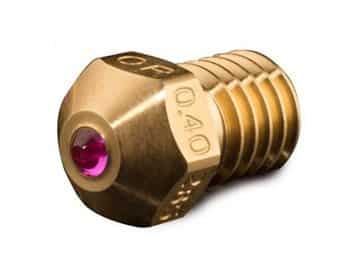
Brass: Non-abrasive materials only
Allows the maker to use a wide variety of materials but is limited to non-abrasive materials.
- PLA
- ABS
- PETG
- Nylon
- TPE
Stainless Steel: Light use with abrasive materials
Allows the maker to use a wide variety of materials. Stainless steel nozzles will need to be replaced more often than hardened steel and ruby tipped nozzles with continued use of abrasive materials.
- NylonX
- Carbon fiber
- Glow-in-the-dark filaments
- Metal filaments:
- Steel-filled
- Iron-filled
- Brass-filled
- Exotic filaments
- Wood-filled
- Ceramic-filled
Hardened Steel: Heavy use with abrasive materials
Allows the maker to use abrasive materials and has a longer lifetime than stainless steel nozzles. This material is recommended for makers who find themselves using abrasive materials a lot.
- Same as Stainless Steel Nozzles
Ruby Tipped: Heavy use with abrasive materials
An alternative option to hardened steel nozzles. Ruby nozzles will last longer than hardened steel nozzles but are much more expensive.
- Same as Stainless Steel Nozzles
Wrapping it Up
As you can see, it’s important to consider which nozzle you’re using when setting up a 3D print. Understanding the advantages and disadvantages of using different nozzles can greatly improve your decisions and enhance your 3D printing skills. Now get out there and start making!
